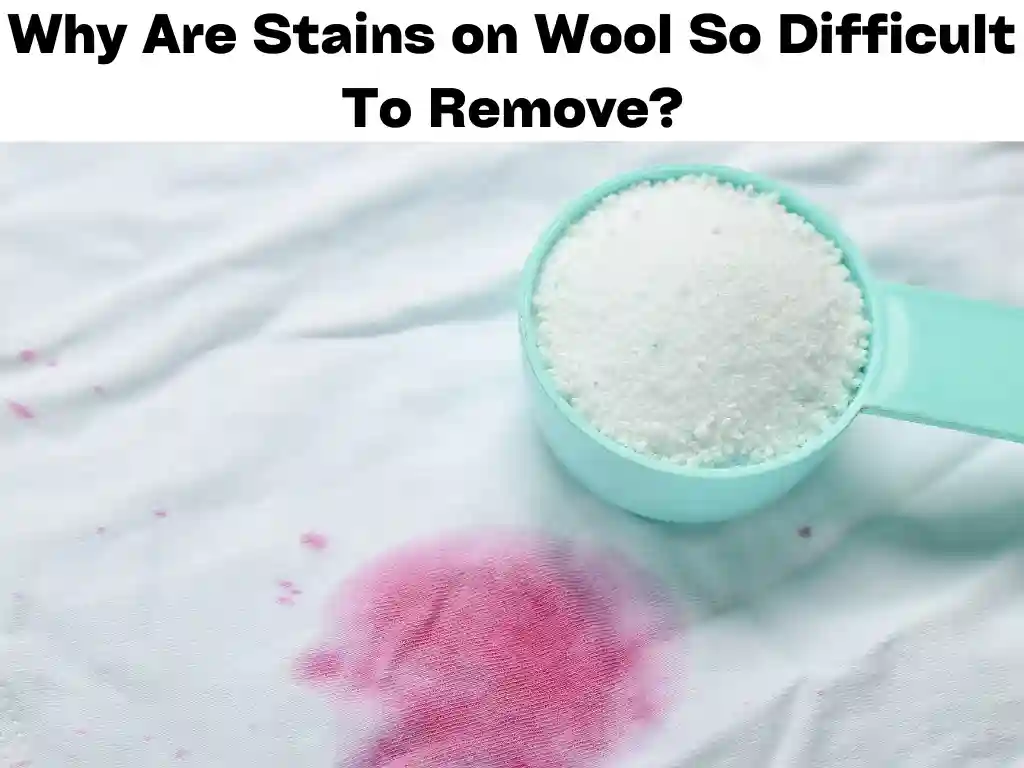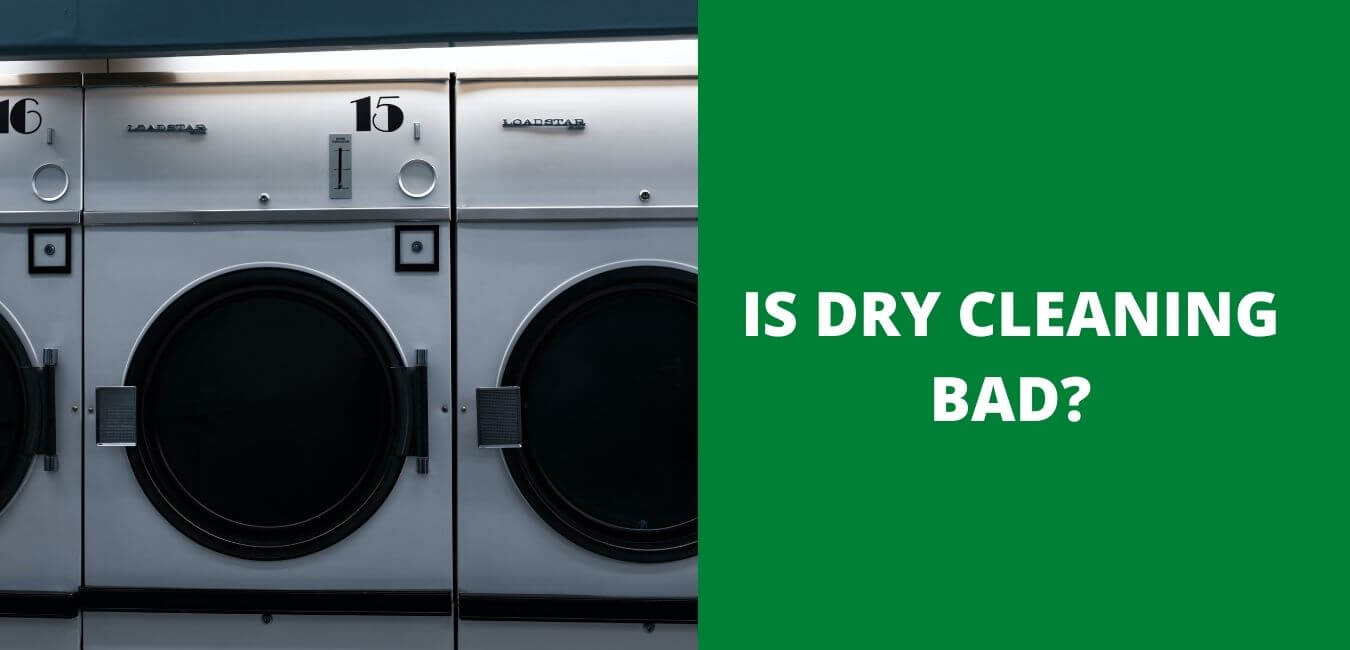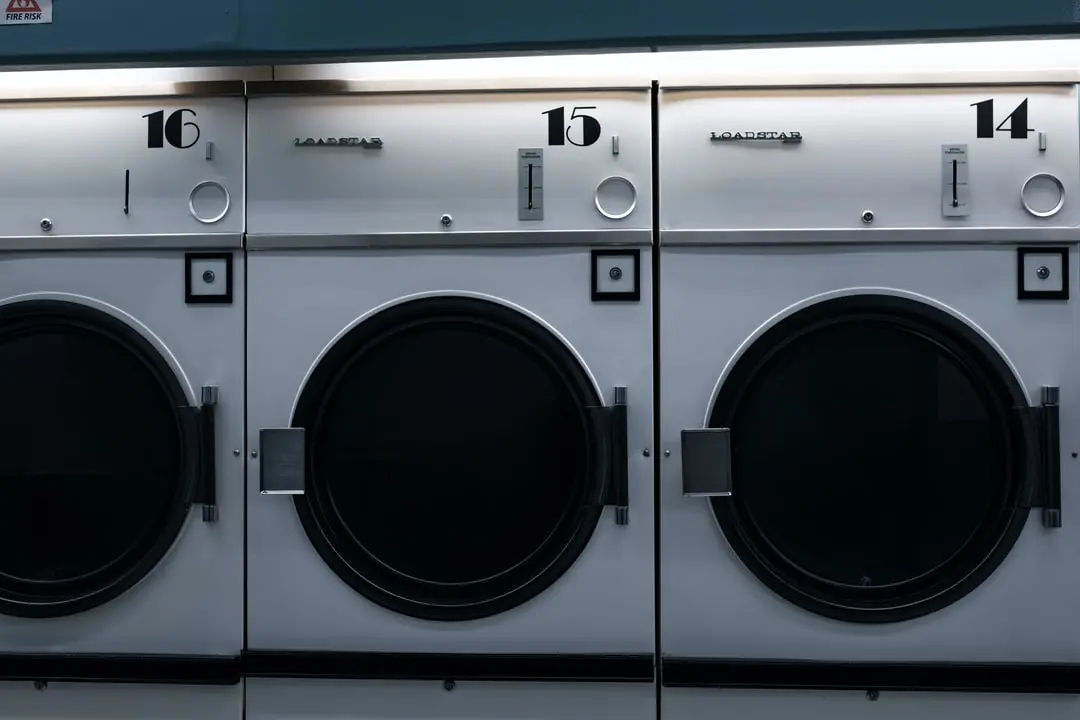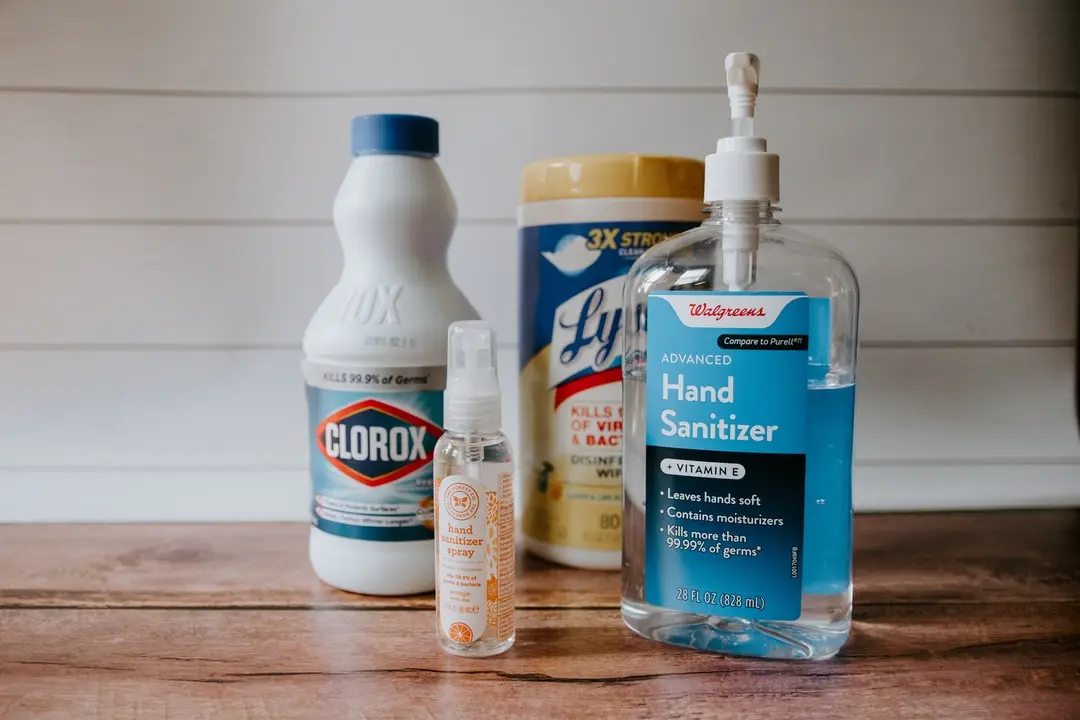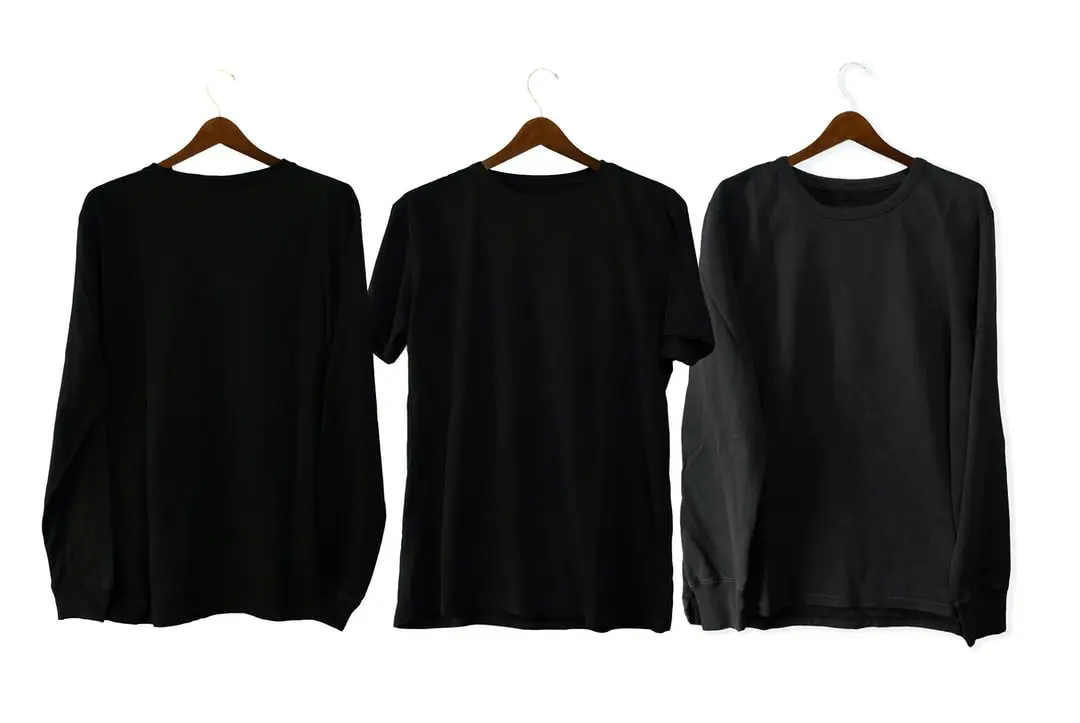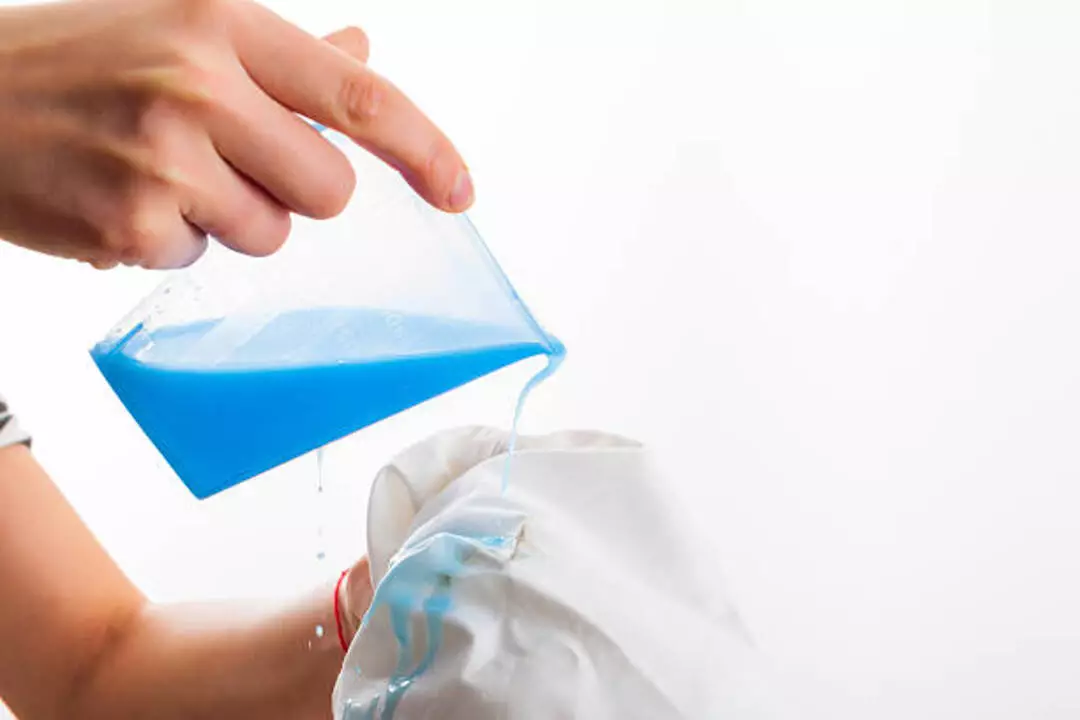Wool fibers are unique—they’re absorbent and delicate, making stains stubborn and challenging to remove.
In this blog, we will explain why it is difficult to remove stains from woolen clothes. We’ll also reveal tips for tackling those pesky marks without ruining your cozy garments. Stay tuned to become a wool-stain-whisperer!
KEY INFORMATION
- Wool fibers soak up liquids and trap both protein-based and oil-based stains, which makes stains hard to get out.
- For wool stain removal, use gentle methods like blotting instead of rubbing, and avoid hot water that can set the stain.
- Acting quickly on spills and using mild, non-alkaline cleaners can help prevent permanent stains on wool clothing.
- Test any cleaner on a small hidden part of the garment first to make sure it doesn’t hurt the fabric.
- If you can’t remove a tough stain from wool at home, taking it to a professional dry cleaner is often the safest choice.
Understanding the Nature of Wool Stains

Woolen clothing stains are notoriously difficult to remove due to the porous nature of wool fibers, which can trap and hold onto both protein-based and oil-based stains. Understanding the different types of stains that commonly affect wool garments will help you approach stain removal effectively.
1. Differences between protein and oil-based stains
Protein and oil-based stains are like two different enemies for wool. Protein stains come from stuff like blood, milk, and grass. These types of stains stick to the wool fibers because wool is also a protein.
Think of it as if they become friends with the fabric, making them hard to remove.
Oil-based stains are slick troublemakers coming from butter or makeup. They slide into the tiny spaces in wool fibers and hold on tight. Getting them out needs you to act fast with something that can break down the oil without hurting the wool itself.
Both kinds need special care when cleaning your favorite sweater or scarf. You have to be gentle so you don’t damage those delicate wool fibers or make colors fade away!
2. The porous nature of wool fibers
Wool fibers are like tiny sponges, soaking up liquids and holding onto them. This porous structure makes it easy for stains to penetrate deep into the fabric, making them more challenging to remove.
When dealing with protein-based stains like blood or milk on wool, their porous nature can trap these substances, requiring careful and gentle cleaning to avoid further damage. Moreover, oils and greasy substances can seep into the wool fibers due to their porosity, demanding thorough treatment before washing to prevent permanent staining.
Additionally, because of its absorbent quality, the presence of moisture in wool fibers can also result in discoloration or damage when exposed to heat during stain removal attempts.
Common Stains on Wool Clothing
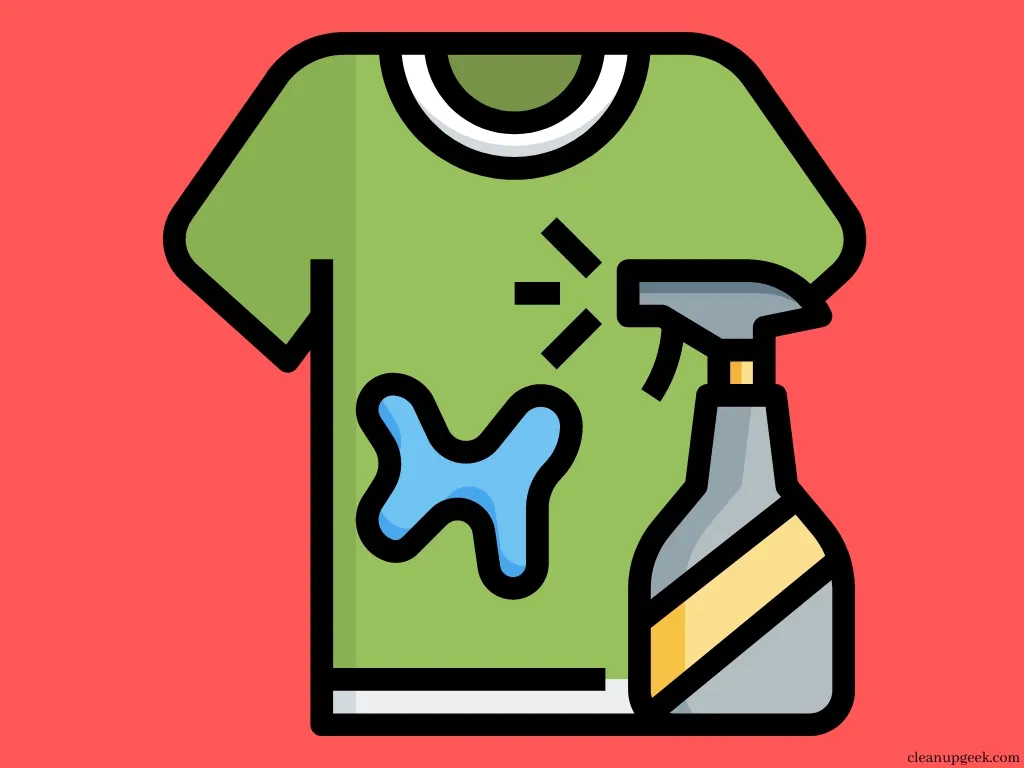
– Wool clothing can easily get stained with grease, sauce, egg, milk, red wine, fruit juice, coffee, tea, hot chocolate, lipstick and more. Each of these stains requires a different approach for effective removal.
1. Butter/grease/sauce stains
Butter, grease, and sauce stains on wool can be tricky to remove. These types of stains are oil-based and can penetrate deeply into the porous wool fibers. To tackle these stubborn stains, start by gently scraping off any excess using a spoon or blunt knife.
Then, apply a small amount of mild detergent or white spirit to the stained area and blot with an absorbent cloth. However, always test in an inconspicuous area first to ensure it doesn’t damage the fabric.
Remember that dabbing is more effective than rubbing when dealing with butter, grease, or sauce stains on wool.
2. Egg/milk stains
Egg and milk stains on wool clothing can be tricky to remove due to their protein-based nature. These stains can penetrate the porous wool fibers, making them more challenging to lift.
To tackle these stains, start by gently blotting the area with a clean cloth to absorb excess moisture. Then, mix a solution of cold water and mild detergent or white vinegar and dab it onto the stain.
Allow it to sit for a few minutes before rinsing with cold water. Avoid using hot water as it can cause the proteins in egg and milk to coagulate, setting the stain further into the fabric.
3. Red wine/fruit/fruit juice stains
Red wine, fruit, and fruit juice stains on wool clothing can be tough to remove. These stains contain natural dyes that can penetrate the wool fibers deeply. Act quickly when dealing with these stains by blotting up as much liquid as possible using a clean cloth.
Then, sprinkle salt on the affected area to absorb more of the stain. Once dry, gently brush off the salt and use a mixture of mild detergent and cold water to dab at the remaining stain.
Rinse well before air-drying.
4. Coffee/tea/milk/hot chocolate/chocolate stains
Removing coffee, tea, milk, hot chocolate, or chocolate stains from wool can be tricky. These drinks and foods often contain proteins or oils that can seep deep into the porous wool fibers.
When dealing with these stains, act quickly to blot up excess liquid gently with a clean cloth. Avoid rubbing the stain to prevent it from setting deeper into the fabric. Then use a mild cleaning solution specifically designed for wool and dab at the stain until it begins to lift.
Remember to test the cleaning solution on a small hidden area of the garment first to ensure it doesn’t cause any discoloration or damage.
5. Alcoholic drink stains
Alcoholic drinks stains on wool can be tricky to remove because the pigments in the drinks can bind with the wool fibers. When dealing with such stains, start by blotting the area with an absorbent cloth or paper towel.
Apply a small amount of mild detergent mixed with water and gently dab at the stain; avoid scrubbing as this might damage the fabric. Rinse thoroughly and repeat if needed before allowing it to air dry to prevent shrinking or damage from heat.
To ensure success, first test any cleaning solution on a small, inconspicuous area of the garment. If uncertain about treating alcoholic drink stains on wool clothing, it’s best to seek professional help for safe and effective removal without risking further damage.
6. Lipstick/makeup/shoe polish stains
Lipstick, makeup, or shoe polish stains on wool can be tricky to remove. These stains are oil-based and can quickly seep into the porous wool fibers. To tackle these tough stains, start by gently scraping off any excess residue with a spoon or blunt knife without rubbing it in further.
Dab the stained area with a cleaning solution specifically designed for oil-based stains on wool, like white spirit or spot-cleaning sprays. Always test the solution on a small, hidden area before applying it to the stain directly.
Remember that using gentle dabbing motions and taking your time is crucial when dealing with these stubborn stains.
7. Blood stains
Blood stains on wool clothing can be tricky to remove due to the protein nature of the stain and the delicate nature of wool fibers. When dealing with blood stains, act quickly by gently blotting the area with a clean cloth or sponge to absorb as much liquid as possible.
Then, soak the garment in cold water and mild detergent for about 30 minutes before washing it gently. Avoid using hot water or rubbing vigorously, as this can cause the stain to set further into the fabric.
For tough blood stains, consider seeking professional dry cleaning services for safe and effective removal.
8. Grass stains
Grass stains on wool clothing can be tricky to remove because the chlorophyll in grass is a natural dye that can adhere deeply to wool fibers. To tackle grass stains, start by carefully scraping off any excess grass with a spoon or blunt knife.
Then, apply a small amount of white vinegar directly onto the stain and gently blot it with a clean cloth. Follow this by applying a mild detergent mixed with cold water to the affected area and dabbing it gently.
Rinse thoroughly and repeat if necessary before air-drying the garment.
9. Ink/ballpoint pen stains
Ink and ballpoint pen stains on wool clothing can be quite tricky to remove. Because of the porous nature of wool fibers, ink can quickly seep into the fabric, making it challenging to eliminate the stain completely.
When dealing with ink stains on wool, it’s essential to act promptly. Blot the stain gently with a clean cloth or paper towel to absorb as much ink as possible without spreading it further into the fabric.
Avoid rubbing or scrubbing aggressively, as this can cause the ink to spread and set deeper into the fibers of the wool garment. Remember that using harsh cleaning solutions or excessive agitation can damage the delicate structure of wool fibers and may worsen the stain.
Tips and Tricks for Removing Stains from Wool
Act quickly when dealing with stains on wool clothing to increase the chances of successful removal. Use gentle, non-alkaline cleaning solutions and avoid rubbing the stain, opting to dab it instead.
Also, consider professional dry cleaning for tough stains on wool garments.
1. Act quickly
If you spill something on your wool clothing, act quickly. The longer a stain sits, the harder it is to remove. Blot the stain with a clean cloth to soak up as much of the liquid or substance as possible.
Avoid rubbing, which can spread the stain and push it deeper into the fabric. Work from the outside of the stain toward the center to prevent spreading. Take care when blotting not to scrub aggressively, especially if dealing with delicate fibers like merino wool.
2. Use gentle, non-alkaline cleaning solutions
To remove stains from wool, use mild cleaning solutions that are not too strong or harsh. Harsh cleaners can damage the delicate wool fibers and make stains harder to remove. Instead, opt for non-alkaline solutions that are gentle on the fabric while effectively lifting stains.
The pH level of the cleaning solution matters, so choose a product with a pH closer to neutral to ensure it’s safe for wool. This approach helps protect the natural integrity of the wool while effectively removing stains without causing any additional harm.
When dealing with tough stains on your beloved wool clothing items, using mild and non-alkaline cleaning solutions is crucial. These solutions help maintain the delicate nature of wool fibers while tackling those stubborn marks effectively.
3. Dab, not rub, the stain
When dealing with stains on wool, remember to dab the stained area gently with a clean cloth or sponge. Avoid rubbing, as this can spread the stain further into the fabric and cause damage to the wool fibers.
Dabbing helps to lift the stain without causing additional harm to the delicate nature of wool. By dabbing, you can absorb the stain effectively without compromising the integrity of the fabric.
Always think protection when cleaning stains from wool – you’re preserving both your garment and its quality by following these gentle methods!
4. Test a small area first
Before attempting to remove a stain from your wool clothing, it’s crucial to test any cleaning solution on a small, inconspicuous area of the garment. This helps ensure that the solution won’t cause discoloration or damage to the fabric.
Since wool is sensitive and prone to color changes, testing first can prevent further harm to your clothing. Also, different fabrics may react differently to cleaning solutions, so it’s wise to check how the fabric responds before tackling the entire stain.
Remember that this simple step can save you from potential disappointment and help maintain the quality of your beloved wool garments.
5. Rinse well before washing
Before washing your wool clothing, it’s crucial to rinse the stained area thoroughly. Use cold water to gently flush out as much of the stain as possible. The tip is especially useful for removing salt and alcoholic drink stains from wool garments.
By rinsing well before washing, you can prevent the setting of stains and improve the effectiveness of subsequent stain removal methods. Remember that wool is sensitive to heat and agitation, so it’s important to be gentle during this process.
After rinsing, carefully proceed with stain removal using appropriate cleaning solutions or spot-cleaning sprays as per specific guidelines for wool fabric care, ensuring you test a small area first.
6. Consider professional dry cleaning for tough stains
For tough stains on wool clothing, professional dry cleaning can be the best solution. Professional cleaners have expertise in handling delicate fabrics like wool and can use specialized techniques and solutions to effectively remove stubborn stains without causing damage to the fabric.
They understand the nature of wool fibers and know how to treat different types of stains, ensuring that your garments are returned clean and well-maintained.
In addition, professional dry cleaners also have access to specialized equipment that allows them to gently but thoroughly clean wool clothing, removing tough stains while preserving the integrity of the fabric.
Caring for Wool Clothing

Properly care for your wool clothing by washing and removing stains with gentle, non-alkaline cleaning solutions, protecting them during wear and storage, and following specific care instructions for different fibers.
For more detailed advice on caring for wool clothing, continue reading the full blog post.
1. Washing and stain removal advice
To properly care for wool clothing and effectively remove stains, follow these tips:
- Use a gentle, non – alkaline cleaning solution suitable for wool to treat stains.
- Act quickly and dab the stain with a clean cloth to absorb excess moisture.
- Test the cleaning solution on a small, inconspicuous area of the garment before applying it to the stain.
- Avoid using hot water or strong agitation that could damage the fabric when washing wool clothing.
- For tough stains like grease or oil, gently scrape off any excess with a spoon or blunt knife before treating the stain.
- Rinse the stained area well with cool water after treating it to ensure all residue is removed.
- Consider professional dry cleaning for stubborn or delicate stains to avoid further damage to the fabric.
2. Protecting wool clothing during wear and storage
To keep your wool clothing in top condition, make sure to wear an undershirt or camisole underneath to protect the garment from sweat and body oils. Always allow your wool clothing to rest for at least a day between wears to help it recover its shape and prevent excessive wrinkling.
When storing wool garments, use padded hangers to maintain their shape and never hang them in direct sunlight as this can cause fading. To prevent damage from moths, store your wool items in breathable cotton garment bags with natural moth repellents like cedar chips or lavender sachets.
Regularly air out stored wool clothing and spot-clean any stains using gentle methods before putting them away for the season.
3. Specific care for merino wool and silk garments
When caring for merino wool and silk garments, it’s important to avoid using hot water or high heat when washing or drying. The delicate nature of these fabrics requires gentle handling.
Use mild detergent and cool water, and avoid wringing or twisting the fabric to prevent stretching or distortion. Additionally, air-drying is preferable to machine drying as excessive heat can damage the fibers.
When storing merino wool and silk garments, ensure they are clean and completely dry to prevent any potential damage from moisture or mold growth. Using moth repellents can also help protect these garments during storage.
Remember that merino wool and silk require special attention due to their sensitive nature. To keep them in good condition, it’s crucial to follow specific care guidelines. When removing stains from merino wool or silk clothing, always opt for gentle methods such as dabbing with a mild cleaning solution rather than harsh rubbing which could cause damage.
4. Care for other fibers such as cotton, linen, and bamboo
When caring for fibers like cotton, linen, and bamboo, it’s crucial to follow specific guidelines. These fibers can withstand more robust cleaning methods compared to delicate wool.
For instance, cotton and linen can generally tolerate higher temperatures during washing. It’s also important to consider the color-fastness of these fabrics before applying any stain removal techniques.
Bamboo fabric is known for its durability and moisture-wicking properties but requires gentle care during laundering to maintain its integrity. When dealing with stains on these fibers, using mild detergents and avoiding harsh chemicals is key to preserving their quality.
Conclusion and final thoughts
In conclusion, woolen clothing stains are difficult to remove due to the structure of wool fibers. They can hold onto moisture and absorb stains more easily than other fabrics. Also, harsh cleaning methods can damage the delicate nature of wool.
So, it’s essential to act quickly and use gentle cleaning solutions when dealing with stains on wool garments. Remember that proper care is crucial for maintaining the quality and appearance of your beloved wool clothing items.
FAQs

1. Why are stains on wool clothes tough to get out?
Wool fibers hold onto stains strongly because they’re not smooth like other fabrics, making it hard for you to remove spots and spills.
2. Can you give tips for getting rid of stains on wool?
Yes! To remove common stains from wool, act quickly by blotting, use cold water and a gentle cleaner made for wool, then rinse well.
3. How do I take grease off my wool sweater?
To pull grease out of a wool garment, put talcum powder on the spot, let it sit to soak up the oil, and brush it away gently after a few hours.
4. Is there a way to remove old stains from my merino wool clothing?
For removing old stains from merino or any kind of woolen clothing: mix mild detergent in lukewarm water; soak the area; then pat dry with care.
5. What should I remember about keeping my wool items free from spots?
Remember, regular maintenance helps keep your woollen wear clean—deal with spills quickly, wash carefully as instructions say, and store your clothes right.
